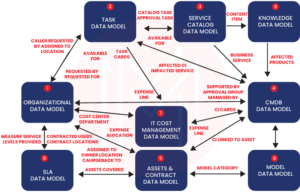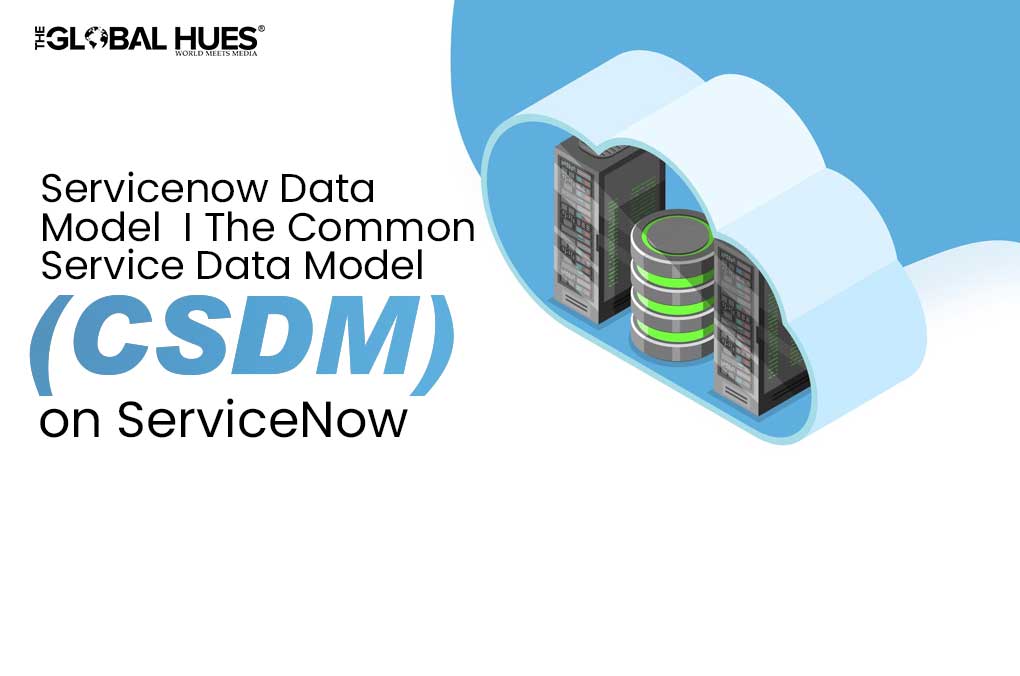ServiceNow is an enterprise cloud platform that helps organizations to manage their workflow, automate processes, and provide visibility into the entire IT landscape. The ServiceNow data model is a powerful tool that helps organizations to better understand and manage their data. It provides an organized structure for managing various kinds of business data from applications, databases, and service requests. By using this data model, organizations can quickly access and analyze large amounts of data in order to make informed decisions about their operational activities.
What is CSDM (Common Service Data Model)?
CSDM (Common Service Data Model) is a standardized model that enables organizations to consolidate their customer service operations into one unified platform. CSDM provides an organized framework for the data and operations associated with the customer service process, as well as for other business processes that may be related. By enabling all of these different systems to talk to each other, CSDM helps make it easier for businesses to provide better customer services.
The idea behind CSDM is simple: instead of having separate systems for handling different customer service tasks, such as call routing and billing, all of those functions can be managed on a single platform. This makes it easier for companies to track and analyze customer interactions, while providing them with the ability to make real-time decisions based on the available data. Get this Servicenow Online Training course that will help you learn the Servicenow ideas if you want to improve your professional abilities on the Servicenow.
Real-world CMDB challenges
We observe that a number of CMDB-related problems are being faced by our clients:
- CIs can be classified and linked to business capabilities, products, and services through customizations that address CMDB data concerns.
- CMDB architectural alignment is mediocre to non-existent.
- Working in silos limits ownership of data and stakeholder collaboration.
- There are no established IT Infrastructure Library Service Management Principles.
- Services are not formally defined.
- Low CMDB awareness and visibility leads to a lack of ownership, an incomplete CMDB, and a threat to the core ITSM procedures.
Key Benefits of The CSDM
1. Helps with the CMDB’s optimization
Your CMDB is enhanced by the CSDM, which ultimately makes it simpler to use and maintain. Many ServiceNow users undervalue the effort and time required to maintain a CMDB. Prior to CSDM, the CMDB was unable to rapidly map the initial business outcomes. On the other hand, the CSDM must eliminate this gap by succinctly and explicitly connecting the site to the technical foundation. The basic tables of the CMDB include details on technical services, service portfolios, business applications, and more.
The CSDM then analyzes the technological and physical consequences of your business models, redesigns how they interact, and maximizes their potential. ServiceNow’s standard tables guarantee that accurate and thorough reporting complies with requirements.
2. A stronger connection to the unified data model
No matter if you use a variety of ServiceNow modules or only its well-known Information Technology Service Management, having a single, consistent data model is advantageous (ITSM). By establishing a CMDB basic table that all other base tables can extend, all services that interact with customers and internal operations are covered. This feature facilitates the management of related data types and establishes a more effective connection between customer-facing and internal technical services.
Because it combines business and service data, it enables better decision-making. Both the commercial and technical teams profit from this. Service teams can view all aspects of their operations, including upstream and downstream processes, by adhering to the CSDM architecture.
3. Enhanced services at reduced costs
When applied properly, a unified data model with a broad perspective enhances services by producing higher-quality output. This provides access to a wide range of advancements, such as:
- IT and business cooperation has improved.
- Accountability in IT has increased.
- The service is apparent throughout the entire process.
- The customer experience will be improved, and business operations will be simpler.
Your ServiceNow instance will have a better return on investment as a result. Enhanced workflows spot opportunities for increased productivity and cost savings, which helps with cost cutting. Additionally, increased visibility enables you to do a more thorough analysis of your company’s operating expenses and locate potential cost-saving measures.
4. Possibilities for increased innovation and agility
ServiceNow’s CSDM best practices boost enterprise-wide operations and business results, enabling greater agility and innovation. Additionally, it enables firms to improve their capacity for innovation and agility. Improved visibility enables quicker decision-making and adaptation to new opportunities.
The next step in ensuring long-term success is to pursue innovation with an agile mindset that allows you to improve across the board, from increasing productivity to streamlining workflows and processes for your teams and reducing costs. This is done after achieving improved customer outcomes through the use of the CSDM.
How to get started with CSDM
It is better to follow the ServiceNow crawl, walk, run, and fly stages than to implement all of the Common Source DataBase (CSDB) functionalities at once. For your apps or services to be effective, you must complete these four phases. Here, we’ll discuss how to successfully implement ServiceNow crawl phases.
1. Make a list of business apps to get started
It is occasionally impossible to have a complete overview of every application, especially in large enterprises. The first step in using CSDM is this. Make sure all of your business applications and application services are available in ServiceNow as a result.
2. Examining the functions and responsibilities related to business applications
Knowing who is in charge of an application service’s operations and quality as well as who is in control of a business application’s ownership is essential. Don’t forget about external providers to whom you’ve assigned responsibility for Application Services as they may host the services in their own (cloud) data center.
3. Determining the business’s importance
You can determine business criticality by conducting a Business Impact Analysis (BIA) with the Business Application Owners and evaluating your services. If you haven’t done so already, you might use the customised tables included in your ITSM bundle to help you collect data from your service owners.
4. Put the most crucial CIs first
During the CSDM Crawl phase, special attention should be paid to important elements including load balancers, application servers, database servers, vital network equipment, and other essential components. Connect these Critical CIs in a straightforward manner. Make sure they are connected to a top-notch application service, and that the application services are linked to the appropriate business application.
5. Expand
You can fill out the most recent batch of company applications here.
Why should we follow the CSDM?
You can use the CSDM as a guide to map your IT services to ServiceNow. The CSDM is a framework for deciding where data for your products should be stored that is based on CMDBs. Additionally, the CSDM is a standard across all ServiceNow products that use the CMDB. The CSDM framework makes sure that the requirements for your ServiceNow application map to the appropriate CMDB tables.
If you don’t adhere to this standard, you could not get the most out of the ServiceNow platform.
What is the Servicenow data model?

Across all ServiceNow platforms and products, the ServiceNow data model is a Configuration Management Database (CMDB) framework that will support and enable various configuration approaches. Authentic service level reporting will be made possible and supported by the Common Service Data Model (CSDM), which also provides prescriptive guidance on service modeling within the CMDB across our products and platform. All ServiceNow products fall under the umbrella of these service-related definitions.
Mid-Server for ServiceNow
The MID Server is a Java programme that functions as a Windows service or UNIX daemon on a server on your local network. Data can move between external applications, data sources, and services thanks to the ServiceNow MID Server’s connections to them.
All communication between the MID Server and the ServiceNow instance is started by the MID Server. This communication is recorded in the ECC Queue, which acts as a communication log between the representative and the MID Server. Any work that the MID Server needs to complete is retrieved from the ECC Queue, and it then returns the finished product to the queue.
Conclusion
In conclusion,ServiceNow Data Model is an invaluable tool for managing a variety of data and information. It offers a wide range of features that make it easier to store, organize, and analyze data efficiently. This includes the ability to create models and relationships between elements, as well as the ability to add custom fields. In addition, ServiceNow Data Model provides users with access to pre built models and templates for managing common types of data.



